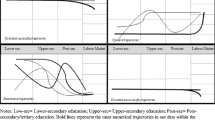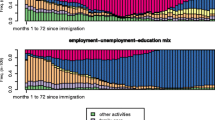Abstract
Educational attainment in one’s youth generally leads to a more successful transition to adulthood. However, the number of years that youth spend in the educational system is affected by personal characteristics and social context. For immigrants who arrive in a country as children, one of these variables is national or geographical origin, which influences the type of adjustment challenges they must face. Receiving countries must make a major effort to integrate this student population into their educational systems, in order to ensure, as far as possible, that equal opportunities are available to all. The present study analyses the educational trajectory of young people (aged 15–34) in Catalonia (Northeast Spain) and the relationship between the desired and actual level of education attained. Kaplan–Meier and Cox models (survival analysis) were fitted to assess the influence of different variables in explaining the time spent in the education system. After controlling for personal, parental and contextual factors, we found that Moroccan youth have a higher risk of abandoning their studies, and therefore attain a lower educational level. However, Latin-American populations are more likely to feel dissatisfied with the level achieved.


Similar content being viewed by others
Notes
Although we consider this expression to be incorrect in the sense that the immigrants’ descendants are not immigrants, by definition, we adopt it here because it is widely used in the literature on migrations.
European Commission (2015), Youth Unemployment, http://ec.europa.eu/europe2020/pdf/themes/21_youth_unemployment.pdf. Accessed 16 April 2015.
The same author also questions the negative connotations of the concept and the association attributed to their age, proposing more precise indicators.
Percentage of the population aged 18–24 with at most a lower secondary education and not in further education or training. Source: Eurostat, Basic figures on the EU (Summer 2013 edition).
Data from the Department of Education, Generalitat de Catalunya.
Enquesta a la Joventut de Catalunya de 2012 (EJ12) (http://benestar.gencat.cat/ca/ambits_tematics/joventut/observatori_catala_de_la_joventut/).
Padrón Continuo de Habitantes (www.ine.es).
This is the mandatory secondary education (Enseñanza Secundaria Obligatoria, ESO), normally completed by 16 years old.
In the sample, 96.6 % of the young people born in the Maghreb, were born in Morocco.
It has to be pointed out that the lack of significance observed for other African origins could be a consequence of the considerably smaller simple size of this category. Future research should focus more extensively on youth from other origins (also Asian countries) to be able to confirm the worst position already observed for Maghrebians.
References
Alba, R. (2005). Bright vs. blurred boundaries: Second generation assimilation and exclusion in France, Germany, and the United States. Ethnic and Racial Studies, 28(1), 20–49. doi:10.1080/0141987042000280003.
Alba, R., & Nee, V. (2003). Remaking the American mainstream: Assimilation and contemporary immigration. Cambridge: Harvard University Press.
Alba, R., Sloan, J., & Sperling, J. (2011). The integration imperative: The children of low-status immigrants in the schools of wealthy societies. Annual Review of Sociology, 37, 395–415.
Aparicio, R. (2007). The integration of the second and 1.5 generations of Moroccan, Dominican and Peruvian origin in Madrid and Barcelona. Journal of Ethnic and Migration Studies, 33(7), 1169–1193. doi:10.1080/13691830701541713.
Aparicio, R., & Portes, A. (2014). Crecer en España. La integración de los hijos de los inmigrantes. Barcelona: Obra Social “La Caixa”.
Bertrán Tarrés, M., Ponferrada-Arteaga, M., & Pàmies Rovira, J. (2014). Gender, family negotiations and academic success of young Moroccan women in Spain. Race, Ethnicity and Education. doi:10.1080/13613324.2014.946486.
Box-Steffensmeier, J. M., & Jones, B. S. (2004). Event history modeling. A guide for social scientists. New York: Cambridge University Press. doi:10.1017/CBO9780511790874.
Buchmann, C., DiPrete, T. A., & McDaniel, A. (2008). Gender inequalities in education. Annual Review of Sociology, 34, 319–337.
Carrasco, S., Pàmies, J., & Bertran, M. (2009). Familias inmigrantes y escuela: Desencuentros, estrategias y capital social. Revista Complutense de Educación, 20(1), 55–78.
Carrasco, S., Pàmies, J., Ponferrada, M., Ballestín, B., & Bertran, M. (2013). Segregación escolar e inmigración en Cataluña: Aproximaciones etnográficas. Emigra Working Papers, 126, 1–26.
Cea d’Ancona, M. A., & Vallés Martínez, M. (2010). Xenofobias y xenofilias en clave biográfica. Madrid: Siglo XXI.
Ceballo, R., Maurizi, L. K., Suarez, G. A., & Aretakis, M. T. (2014). Gift and sacrifice: Parental involvement in Latino adolescents’ education. Cultural Diversity and Ethnic Minority Psychology, 20(1), 116–127.
Cebolla Boado, H., & Martínez de Lizarrondo, A. (2015). Las expectativas educativas de la población inmigrante en Navarra. ¿Optimismo inmigrante o efectos de escuela? Revista Internacional de Sociología, 73(1), 1–13. doi:10.3989/ris.2013.02.22.
Cebolla, H., & Requena, M. (2009). Los inmigrantes marroquíes en España. In David Reher & Miguel Requena (Eds.), Las múltiples caras de la emigración en España (pp. 251–287). Madrid: Alianza.
Dwyer, C., Bindi, S., & Sanghera, G. (2008). ‘From cricket lover to terror suspect’—Challenging representations of young British Muslim men. Gender, Place and Culture: A Journal of Feminist Geography, 15(2), 117–136. doi:10.1080/09663690701863208.
Garreta Bochaca, J. (2006). Ethnic minorities and the Spanish and Catalan educational systems: From exclusion to intercultural education. International Journal of Intercultural Relations, 30(2), 261–279. doi:10.1016/j.ijintrel.2005.11.006.
Gibson, M. A., & Carrasco, S. (2009). The education of immigrant youth: Some lessons from the U.S. and Spain. Theory into Practice, 48(4), 249–257. doi:10.1080/00405840903188118.
Giliberti, L. (2013a) La condición inmigrante y la negritud en la experiencia escolar de la juventud dominicana: estigmas y formas de agencia. Una etnografía transnacional entre la periferia de Barcelona y Santo Domingo. Ph.D. Thesis: Universidad de Lleida.
Giliberti, L. (2013b). Escuela y reproducción social: las prácticas ocultas en los sistemas educativos español y dominicano. Mondi Migranti. Revista di studi e ricerche sulle migrazioni internazionali, 2, 221–238.
Hallam, S., & Ireson, J. (2003). Secondary school teachers’ attitudes towards and beliefs about ability grouping. British Journal of Education Psychology, 73(3), 343–356. doi:10.1348/000709903322275876.
Hargreaves, D. H., Hester, S., & Mellor, F. J. (1975). Deviance in Classrooms. London: Routledge & Kegan Paul.
Huntington, S. (2004). The hispanic challenge. Foreign Policy, 14, 30–45. doi:10.2307/4147547.
Klein, J. P., & Moeschberger, M. L. (2003). Survival analysis: Techniques for censored and truncated data (2nd ed.). New York: Springer.
Lee, E. T., & Wang, J. W. (2003). Statistical methods for survival data analysis (3rd ed.). Belmont, CA: Lifetime Learning Publications.
Lomi, A., Snijders, T. A. B., Steglich, C. E. G., & Torló, V. J. (2011). Why are some more peer than others? Evidence from a longitudinal study of social networks and individual academic performance. Social Science Research, 40, 1506–1520. doi:10.1016/j.ssresearch.2011.06.010.
Miguel-Luken, V. de (2013). Població d’origen estranger. Transicions accelerades en un context de vulnerabilitat. Enquesta a la joventut de Catalunya 2012 (Vol. 2, pp. 219–266). Barcelona: Secretaria per a la Joventut, Generalitat de Catalunya.
Ministerio de Educación (2011). Panorama de la educación. Indicadores de la OCDE 2011. Informe español. Madrid.
Miret i Gamundi, P., Salvadó i Nayach, A., Serracant i Melendres, P. & Soler i Martí, R. (2008). Enquesta a la joventut de Catalunya 2007. Una anàlisi de les transicions educatives, laborals, domiciliars i familiars. Barcelona: Observatori Català de la Joventut IV. Col·lecció: Estudis, 24.
Pàmies, J. (2006). Dinámicas escolares y comunitarias de los hijos e hijas de familias inmigradas marroquíes de la Yebala en la periferia de Barcelona. Ph.D. Thesis, Universitat Autònoma de Barcelona.
Pàmies, J. (2008). Identitat, integració i escola. Joves d’origen marroquí a la perifèria de Barcelona. Barcelona: Secretaria de Joventut. Generalitat de Catalunya.
Pàmies-Rovira, J. (2012). Moroccan Immigrants at a Secondary School in Catalonia. In Spinthourakis, J. A., J. Lalor &·W. Berg (Eds.), Cultural diversity in the classroom. A European comparison. VS Research, pp. 79–94.
Portes, A., Aparicio, R., Haller, W., & Vickstrom, E. (2011). Progresar en Madrid: aspiraciones y expectativas de la segunda generación en España. Revista Española de Investigaciones Sociológicas, 134, 55–86. doi:10.5477/cis/reis.134.55.
Portes, A., & Rivas, A. (2013). The adaptation of migrant children. The Future of Children, 21(1), 219–246. doi:10.1353/foc.2011.0004.
Portes, A., & Rumbaut, R. G. (2001). Legacies: The story of the immigrant second generation. Berkeley, CA: University of California Press.
Recaño, J., Roig, M., & de Migue, V. (2015). Spain: A new gravity centre for Latin American migration. In A. Domingo i Valls, et al. (Eds.), Demographic analysis of Latin American immigrants in Spain. Cham: Springer.
Rosenthal, R., & Jacobson, L. (1968). Pygmalion in the classroom. New York, NY: Holt.
Serra, C. (2010). Política a ciegas. Déficit de atención en el seguimiento de las trayectorias académicas del alumnado inmigrante en el paso de los estudios obligatorios a los postobligatorios. In Grupo Interdisciplinario de Investigador@s Migrantes (coord.) (Ed.), Familias, niños, niñas y jóvenes migrantes. Rompiendo estereotipos (pp. 139–147) Madrid: IEPALA editorial.
Serracant, P. (2014). A brute indicator for a NEET case: Genesis and evolution of a problematic concept and results from an alternative indicator. Social Indicators Research, 117(2), 401–419. doi:10.1007/s11205-013-0352-5.
Silberman, R., Alba, R., & Fournier, I. (2007). Segmented assimilation in France? Discrimination in the labour market against the second generation. Ethnic and Racial Studies, 30(1), 1–27. doi:10.1080/01419870601006488.
Simon, B. S. (2001). Family involvement in high school: Predictors and effects. NASSP Bulletin, 85(627), 8–19.
Telles, E. E., & Ortiz, V. (2008). Generations of exclusion (Mexican-Americans, Assimilation, and Race). New York: Russell Sage Foundation.
Terrén, E. (2011). Identidades desterritorializadas. El sentimiento de pertenencia nacional entre los adolescentes de familias inmigradas. Papers. Revista de Sociologia, 96(1), 97–116.
Verkuyten, M., & Thijs, J. (2004). Global and ethnic self-esteem in school context: Minority and majority groups in the Netherlands. Social Indicators Research, 67, 253–281. doi:10.1023/B:SOCI.0000032339.86520.5f.
Vittinghoff, E., & McCulloch, C. E. (2006). Relaxing the rule of ten events per variable in logistic and Cox regression. American Journal of Epidemiology, 165(6), 710–718. doi:10.1093/aje/kwk052.
von Below, S. (2007). What are the chances of young Turks and Italians for equal education and employment in Germany? The role of objective and subjective indicators. Social Indicators Research, 82, 209–231. doi:10.1007/s11205-006-9038-6.
Yiu, J. (2013). Calibrated ambitions: Low educational ambition as a form of strategic adaptation among Chinese youth in Spain. International Migration Review, 47(3), 573–611. doi:10.1111/imre.12037.
Acknowledgments
We would like to thank the Secretaria per a la Joventut, of the Generalitat de Catalunya, for providing us with the microdata file for the analysis and all the information needed about the survey. We would also like to thank the reviewers for their valuable comments, which have improved the preliminary version of this paper.
Author information
Authors and Affiliations
Corresponding author
Additional information
This work is part of the following research project ‘Geographic mobility and housing: Spain in an international perspective’ (CSO2013-45358-R) and ‘Family challenges at the beginning of the XXIst century: the impact of family individualization on culture, fertility and social welfare’ (CSO2013-46440-P), funded by the Ministry of Economy and Competitiveness.
Rights and permissions
About this article
Cite this article
de Miguel-Luken, V., Solana-Solana, M. Immigrants in the Educational System in Spain: Who Persists?. Soc Indic Res 132, 733–755 (2017). https://doi.org/10.1007/s11205-016-1323-4
Accepted:
Published:
Issue Date:
DOI: https://doi.org/10.1007/s11205-016-1323-4




